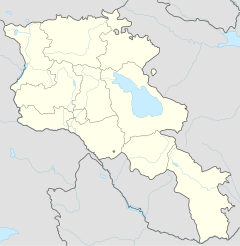
The Robert-Bourassa generating station, formerly known as La Grande-2 (LG-2), is a hydroelectric power station on the La Grande River that is part of Hydro-Québec's James Bay Project in Canada. The station can generate 5,616 MW and its 16 units were gradually commissioned between 1979 and 1981. Annual generation is in the vicinity of 26500 GWh.

Lake Qaraoun is an artificial lake or reservoir located in the southern region of the Beqaa Valley, Lebanon. It was created near Qaraoun village in 1959 by building a 61 m-high (200 ft) concrete-faced rockfill dam in the middle reaches of the Litani River. The reservoir has been used for hydropower generation, domestic water supply, and for irrigation of 27,500 ha.

The Tsankov Kamak Hydroelectric Power Plant, also Tsankov Kamak HPP, comprises an arch dam and hydroelectric power plant (HPP) on the territory of the village of Mihalkovo, southwestern Bulgaria. It is situated on the Vacha River in Smolyan Province, on the borders of Pazardzhik Province and Plovdiv Province, roughly 40 kilometres (25 mi) southwest of Plovdiv and downstream (north) of the town of Devin. It is a part of the Dospat–Vacha Hydropower Cascade (500.2 MW) development of the Vacha River involving five dams and seven power stations in the provinces of Smolyan, Plovdiv and Pazardzhik, 250 kilometres (160 mi) southeast of the capital Sofia. The other four dams are Dospat, Teshel, Vacha and Krichim.

The Ponmudi Dam is a concrete gravity dam built across the Panniyar river which is a tributary of Periyar river at Konnathady panchayath of Konnathadi village in Idukki district of Kerala, India. The dam was constructed in 1963 as a part of a hydroelectric project. Construction was led by E.U.Philipose, Superintending Engineer, Kerala State Electricity Board. It has a length of 288.80 metres (947.5 ft). The hydropower component of the dam has an installed capacity of 30 MW with firm power of 17 MW, generating 158 GWh annually. Taluks through which the river flow are Udumbanchola, Devikulam, Kothamangalam, Muvattupuzha, Kunnathunadu, Aluva, Kodungalloor and Paravur.

The Samanala Dam is a dam primarily used for hydroelectric power generation in Sri Lanka. Commissioned in 1992, the Samanalawewa Project is the third-largest hydroelectric scheme in the country, producing 405 GWh of energy annually. It was built with financial support from Japan and the United Kingdom. It is notable for a large leak on its right bank. Power production continues as planned despite the leakage, and the water from the leak now provides two thirds of the water issued by the reservoir for agriculture in downstream areas.

The Badush Dam is an unfinished multi-purpose dam on the Tigris River, located near Badush, 16 kilometres (9.9 mi) northwest of Mosul in the Ninawa Governorate, northern Iraq.

Rangit Dam, which forms the headworks of the Rangit Hydroelectric Power Project Stage III, is a run-of-the-river hydroelectric power project on the Ranjit River, a major tributary of the Teesta River in the South Sikkim district of the Northeastern Indian state of Sikkim. The project's construction was completed in 1999. The project is fully functional since 2000. The project was built at a cost of Rs 4922.6 million. The average annual power generation from the 60 MW project is 340 GWh with firm power of 39 MW.
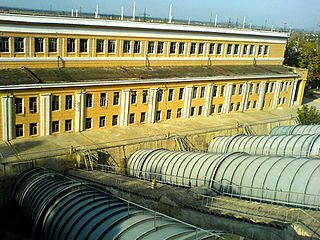
The Farkhad Dam is a hydroelectric and irrigation dam on the Spitamen in Sughd Province, Tajikistan. It is a part of the Naryn-Syr Darya Cascade. The dam is located on the territory of Tajikistan and controlled by Tajikistan, while the Farkhad hydropower station, operated by Uzbekenergo.

Irganai Dam is a hydroelectric dam in the Untskul region of Dagestan, Russia. It is located on the river Avar Koisu.
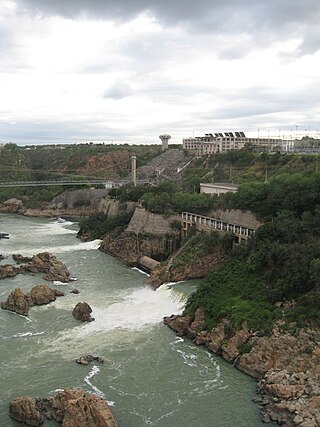
The Paulo Afonso Hydroelectric Complex, also known as the Paulo Afonso Complex, is a system of three dams and five hydroelectric power plants on the São Francisco River near the city of Paulo Afonso in Bahia, Brazil. The complex exploits an 80-metre (260 ft) natural gap on the river, known as the Paulo Afonso Falls. Constructed in succession between 1948 and 1979, the dams support the Paulo Afonso I, II, III, IV and Apollonius Sales (Moxotó) power plants which contain a total of 23 generators with an installed capacity of 4,279.6 megawatts (5,739,000 hp).
The Salto Osório Hydroelectric Power Plant is a dam and hydroelectric power plant on the Iguazu River near Osório in Paraná, Brazil. It is the second dam upstream of the Iguazu Falls and was completed in 1979. The power station has a 1,078 MW capacity and is supplied with water by a rock-fill embankment dam.
The Salto Santiago Hydroelectric Power Plant is a dam and hydroelectric power plant on the Iguazu River near Santiago in Paraná, Brazil. It is the third dam upstream of the Iguazu Falls and was completed in 1979. The power station has a 1,420 MW capacity and is supplied with water by a rock-fill embankment dam.
The Luiz Carlos Barreto de Carvalho Dam is an embankment dam on the Grande River near Fronteira in São Paulo, Brazil. The dam serves an associated hydroelectric power plant with a 1,050 megawatts (1,410,000 hp) installed capacity.
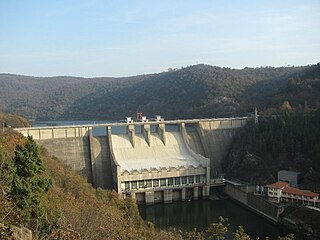
The Ivaylovgrad Dam(язовир "Ивайловград") is located in the eastern Rhodope Mountains and is situated on the Arda river, Southern Bulgaria. There are another two large dams of the Arda upstream - Kardzhali Dam and Studen Kladenets Dam to the west of Ivaylovgrad Dam.

The Entracque Power Plant, also known as The Upper Gesso Plant, is a pumped-storage hydroelectric power station located in Valle Gesso just south of Entracque, Italy. The power station contains pump-generators for two co-located but hydraulically separated power schemes; the Chiotas-Piastra Plant and Rovina-Piastra Plant. Both plants use separate upper reservoirs but use Lago della Piastra as their common lower reservoir. To produce power, water is released from the upper reservoirs to the power station located at the lower reservoir. The pump-generators re-fill the reservoirs and the process repeats as needed. The Chiotas' upper reservoir, Lago del Chiotas, is located much higher in the valley and larger than Rovina's Lago della Rovina which affords it the ability to produce more electricity. The installed capacity of Chiotas is 1,184 megawatts (1,588,000 hp) with a hydraulic head of 1,048 m (3,438 ft) while Rovina has an installed capacity of 133.67 megawatts (179,250 hp) and a head of 598 metres (1,962 ft). Construction on the plant began in 1962 and operations started in 1982. It is owned and operated by Enel.
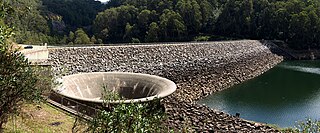
Geehi Dam is a major ungated rockfill embankment dam across the Geehi River in the Snowy Mountains of New South Wales, Australia. The reservoir impounded by the dam is known as Geehi Reservoir.
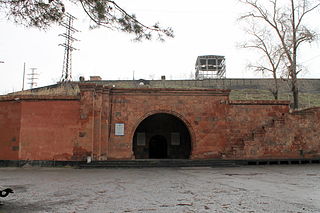
Sevan–Hrazdan Cascade is a complex of hydroelectric power plants on the Hrazdan River and its tributaries between the Lake Sevan and Yerevan in Armenia. They use irrigation water flow from the Lake Sevan and streams waters of Hrazdan River. The cascade is owned by the International Energy Corporation (IEC), a subsidiary of Tashir Group owned by Samvel Karapetyan.
The Toulnustouc generating station, is a hydroelectric power generating station managed by Hydro-Québec on the Toulnustouc River in the territory of Côte-Nord, Quebec, Canada. It has an installed capacity of 526 MW. The power station is fed by water from a dam and dyke that contain the Lake-Sainte-Anne reservoir.

The Mavrovo Hydropower System is a collection of three hydroelectric power plants in North Macedonia. It plays a crucial role in electricity generation within the region. The system includes Vrutok HPP, Rаven HPP, and Vrben HPP. The largest capacity is in the hydropower plant "Vrutok" with four generators. Several kilometers downstream towards Gostivar is the second power plant, "Raven," with three generators. The final power plant in the system is located in the village of Vrben and operates with two generators.
The Batak Hydroelectric Cascade is situated in the Pazardzhik Province, southern Bulgaria and is among the first hydroelectric cascades in the country. Inaugurated on 6 September 1959, it includes seven reservoirs and three underground hydro power plants — Batak, Peshtera and Aleko with a combined installed capacity of 254.2 MW, producing an average of 796 GWh annually.



